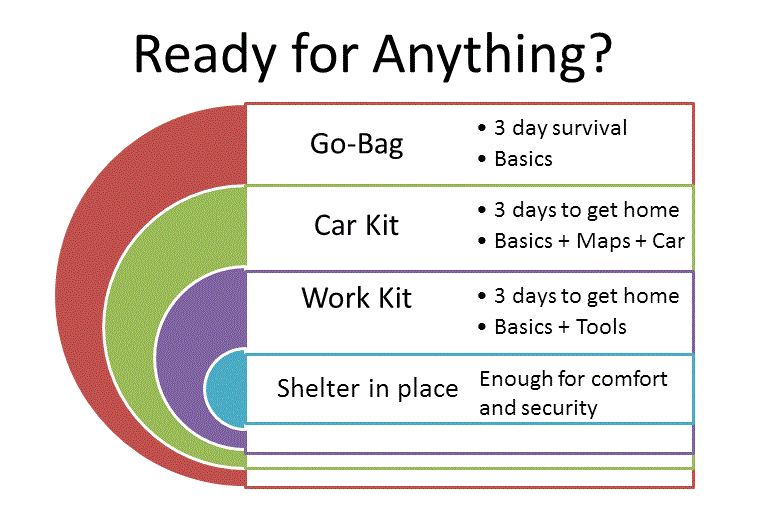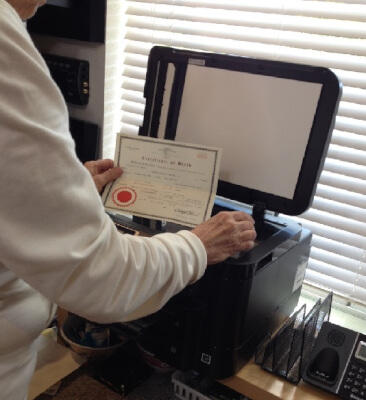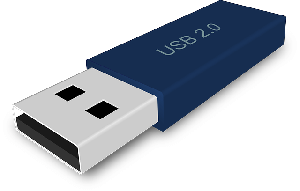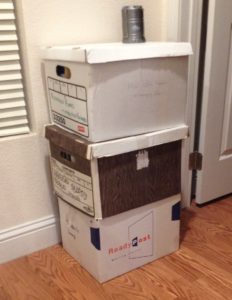What’s your preparedness mindset?

One of my favorite sources of ongoing news and trends is LinkedIn. Members of several LinkedIn groups post daily articles about emergency management technology, jobs, trainings, and new people in the field. (Did you know that the new head of FEMA, Deanne Criswell, is the first woman to head that organization?) The posts and articles also often reveal the state of the “preparedness mindset” of the people writing.
One recurring theme among these professionals, of course, is frustration with getting more people to prepare. It seems that every year a few more people do at least one or two things they call “preparing.” By 2020 people doing one or two things had climbed up to 80%! (Here’s info on the actual National Household Survey.) But only 30% of people are considered to be “prepared.”
Agree or no? “Simple actions get you better prepared.”
Over the past 20 years Joe and I have encouraged our neighbors and our readers to take some of these same preparedness actions. It starts with learning about what’s likely to happen. Then we discuss having some basic strategies and supplies to help carry us through the emergency.
People understand supplies. They are quite happy to buy a few flashlights or some extra jars of peanut butter. Why, when we ask for a show of hands for “Who has extra water stored for emergencies?” we’ll typically get a response of around 70%! People with their hands raised look around with proud smiles on their faces!
Community projects also often focus on supplies. People hand out “emergency kits” to various groups (often seniors or so-called “underserved.”) Volunteers assemble small packs and fill them with donated snacks, a bottle of water and maybe a whistle. When the bags have been distributed, and the number documented, the program is declared a success. (In reality, most of these bags have been raided for the food before the day is over.)
Taking action on supplies is easy and has visible rewards. But it may be misleading.
Controversial mindset: “Having a Go-Bag means you’re prepared.”
One of my favorite active members in LinkedIn emergency preparedness groups is Vincent B. Davis. (You can look him up there to see all his credentials. He has plenty.) I first saw his article about Go-Bags, or disaster kits, in 2020. And he reprinted it again just a week ago.
In Vince’s opinion, disaster kits are “preparedness placebos” and we should stop telling people to get one!
He believes disaster kits will make little difference in a big disaster. Moreover, they let people off the hook and give them a false sense of security. I guess you could say that for Vince, Go-Bags create a false preparedness mindset!
Dangerous assumption: “I have my Go-Bag; I’ve done my share. Now it’s time for the authorities to step in.”
Counting on “the government” or “the authorities” can be disappointing or even deadly. We have seen that there are many circumstances where help may NOT be on the way! Here are some of the obvious ones . . .
- In a widespread local disaster, emergency services can be stretched too thin to cover the entire territory. (That’s where CERT comes in – to provide some assistance until professionals arrive.) Every year, at one of our neighborhood meetings, some people’s “preparedness mindset” is shattered to hear our Fire Department tell us just how low we are on their list of priorities! (We are a senior community!)
- In a regional disaster, your state has to formally declare an emergency before it can ask for Federal assistance. And it may also have to commit to paying part of the bill. These political decisions may take time.
- And during the massive disasters like hurricanes, necessary support may need to come from states or organizations all across the country. It may take days or even weeks for that support to get to your street and your door. We’ll likely see “imported” specialty Search & Rescue teams at work this week. And you may remember the pictures of mile after mile of utility company trucks, coming from states half-way across the country, heading toward Florida after Hurricane Irma hit in 2017.
So what’s the solution to being prepared?
I’ve been thinking a lot about preparing for this summer. It is forecast — and has already proven — to be dangerously hot and dangerously dry, with draught, power outages and wildfires. And that’s just here in the west!
And yes, Joe and I have taken a few actions we think make readiness sense. We’ve refreshed the 55-gallon water barrel and bought a grill so we can cook outdoors if there’s no power to the house.
When I think about it, though, no matter what the season or the weather, in our house we regularly start a conversation with “What if . . ?.” and “How would we handle . . .?” and “I’ll bet that if we . . .” And we spend some time thinking it through to our satisfaction. We have operated with this mindset for years. So for us,
Preparedness is an attitude, not a curriculum! The attitude goes something like this: “Hey, I’m ready for anything! And even if something happens I didn’t prepare for, I’ll have a head start on figuring how to deal with it!”
This is the preparedness mindset we try to inspire in everything we do at Emergency Plan Guide!
Nearly every one of our Advisories tries to deepen our understanding of some aspect of preparedness that we’ve become curious about. (Even if it’s a disaster like a volcano that I’m not likely to experience, or a piece of equipment like an ATV that I’ll never own.)
Every one of our books is full of examples and options – to give people that “head start” on dealing with any unexpected emergency. We think that whatever you do to prepare for one emergency will probably apply in 80% of all cases. With that foundation, we can get to work immediately to solve the particular problem at hand.
Joe and I both had the advantage of active childhoods – and we are particularly interested in making sure young people get exposed to physical risks and challenges along with their digital experiences. I am busy right now working on a presentation for a group of high-school aged Girl Scouts! (More on that to come.)
Quiz: So where does preparedness fit in your mindset?
- Is it built into your daily routines, or is it something you only think about when you catch a glimpse of a disaster on TV?
- Do you keep adding to your knowledge or have you pretty much “been there and done that?”
- What are you doing to give young people more opportunities to develop their strength and problem-solving skills?
Our world doesn’t seem to be getting either safer or easier to navigate. I think that having a “ready for anything” attitude, based on knowledge plus experience, can be a valuable asset.
That’s what keeps us going, anyway!
Virginia
Your Emergency Plan Guide team
P.S. If the concept of having a “head start” sounds attractive to you, please take another look at our Q&A Mini-Series. Each one of the booklets is filled with examples and answers about one basic emergency need, like water, security, communications, etc. The questions in the booklets are great questions for kids, too.








 By now you know that at Emergency Plan Guide, when it comes to survival kits, there’s no such thing as “one size fits all.”
By now you know that at Emergency Plan Guide, when it comes to survival kits, there’s no such thing as “one size fits all.”

